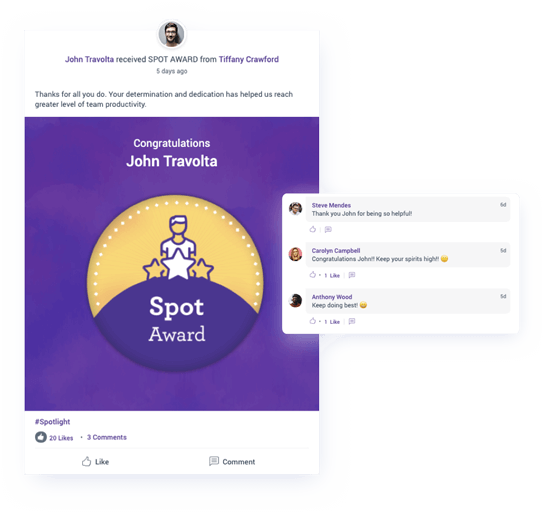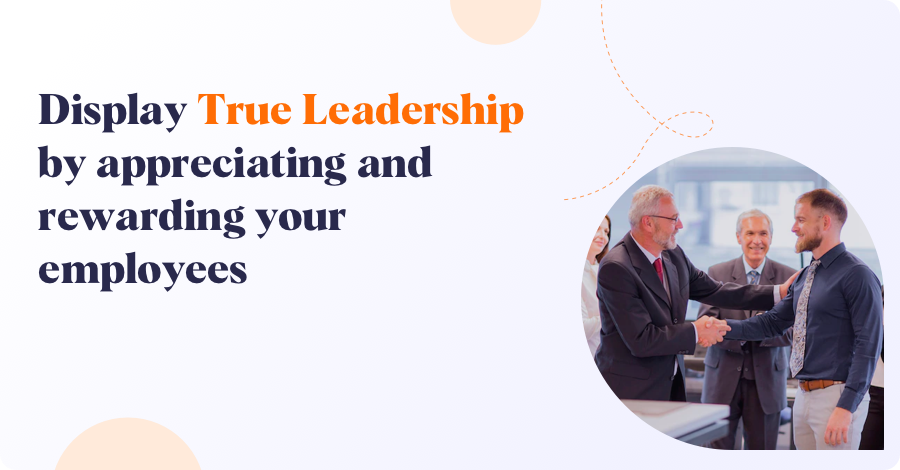8 Stages of Employee Journey That Empower Employees
According to statistics, a great employee onboarding experience helps improve retention by 82%. The numbers show that the employee journey, from onboarding to exit, is crucial to an employee's life.
The entire tenure of an employee needs to be wholesome and valuable. And to do that, you need to implement a strategic journey that the employees will enjoy.
And how are you going to do that? Well, this blog is about leveraging the employees' journey for enhanced productivity.
What is Employee Journey and Why it Matters?
"Employee Journey" refers to an employee's full experience with an organization. From the first contact as a possible recruit to the last day of employment. This journey includes various important stages: recruitment, onboarding, development, retention, and departure. Here's why it matters and how it can help you create a pleasant employee experience:
1. Recruitment and Onboarding:
The journey starts with recruitment, with the goal of attracting the right personnel. A good first impression here sets the tone for the entire relationship. Effective onboarding is critical for integrating new employees into business culture. You need to assist them in understanding their jobs, and making them feel valued and welcomed.
Read more: 8 Easy Steps To Build a New Employee Onboarding Process
2. Development and Growth:
When onboarding an employee, the emphasis changes towards their development. This includes training, career advancement, and possibilities for personal development. Investing in employee development improves their abilities and displays the organization's commitment. It is to support their professional and personal goals, boosting morale and productivity.
3. Retention:
A great employee journey is crucial to retention. Employees who feel valued, recognized, and involved are more likely to remain with the organization. This includes regular feedback, good work atmosphere, recognition, and a good work-life balance.
4. Departure:
Even when employees leave, their final views of the organization are important. A respectful and friendly offboarding procedure can help former employees become brand champions.
Why It Matters
The "Employee Journey" is an important part of the workplace, helping to shape a positive and dynamic work environment. This journey, which includes every stage from recruitment to departure, is critical. It increases employee engagement, retention, and productivity of an organization.
-
A well-designed employee experience attracts top people and strengthens a strong employer brand. This helps the organization stand out in a competitive employment market.
-
Organizations cultivate a dynamic culture that values employees by offering a supportive environment.
-
This strategy guarantees employees feel, involved, and connected to the company's goals and values. This leads them towards increased motivation and job satisfaction.
-
Moreover, it fosters loyalty and dedication resulting in decreased turnover rates. It also transforms employees into brand ambassadors. Furthermore, focusing on the employee journey encourages innovation and creativity. This is because employees who feel supported are more inclined to contribute new ideas and solutions.
Another critical thing is to prioritize employee well-being and work-life balance. It is a part of the journey and improves individual performance. It helps in creating a healthier, more resilient workforce. In short, the employee journey is a strategic business investment. An investment that fosters a vibrant and successful workplace. And not just another human resources initiative.
Creating Value
To deliver a positive employee experience, companies must be-
-
Proactive.
-
Responsive, and
-
Adaptable to their employees' needs and feedback.
Regular communication, a welcoming work culture, recognition and reward systems, and professional and personal development opportunities are all part of this.
The 8 Stages of the Employee Journey You Must Know
Now that you have understood the employee journey and why it matters, let us investigate more. Below is the list of all the necessary stages included in the journey. We will also discuss the common pain points, opportunities for improvement, and actionable steps for each stage:
1. Onboarding
This initial stage sets the tone for the employee's journey. As an employer you need to provide them with a warm welcome. Moreover, you also need to provide them with the tools, information, and connections. This will help them start on a positive note.
- Pain Points: New employees often feel overwhelmed with information, struggle to understand company culture, or lack clear role expectations.
- Opportunities: Streamline the onboarding process, set clear expectations, and integrate company culture.
- Actions: Implement a structured onboarding program that includes mentorship. It should also involve clear communication of job roles and an introduction to company values and culture. This will set the tone for them and make it easier for them to adopt.
Be unbiased with your recruitment and be neutral with your employees.
2. Integration
Integration helps employees assimilate into the company culture and team dynamics. It is about making them feel valued, included, and a part of the organizational fabric.
- Pain Points: Difficulty assimilating into teams, understanding informal company networks, or feeling isolated.
- Opportunities: Facilitating team integration and fostering a sense of belonging.
- Actions: Organize team-building activities and encourage cross-departmental interactions. Furthermore, provide platforms for social engagement within the company. This will ensure that they get acclimated to everyone in the organization. Moreover, it will also help them create good workplace relationships in the long run.
3. Performance and Development
This stage emphasizes continual performance evaluation and personal development. The company offers employees opportunities for learning and advancement tailored to their skills. .
- Pain Points: Lack of clear performance metrics, infrequent feedback, or inadequate professional development opportunities.
- Opportunities: Implementing continuous performance evaluation and promoting personal growth.
- Actions: Set clear, measurable goals, provide regular and constructive feedback. Besides offer continuous learning and development opportunities. With increased learning opportunities, the employees will improve their learning curve. And in the long run will have the chance to get new skills.
4. Career and Growth
The emphasis at this stage is on professional advancement and personal improvement. The organization prioritizes personal aspirations with company objectives by providing clear progression opportunities.
- Pain Points: Limited career advancement paths, lack of transparency in promotion processes, or insufficient skill development.
- Opportunities: Creating clear career progression pathways and supporting skill enhancement.
- Actions: Develop transparent career pathways and provide mentorship programs. Also offer training to upskill employees. A good career path will ensure employees understand their worth. This will help them choose the right path that aligns with their skills.
Include leadership in this process and keep things transparent. With the right support and investment employees can surpass their potential and become good assets for the organization.
5. Recognition and Rewards
This critical stage entails recognizing and rewarding people for their contributions and accomplishments. Hence, cultivating a culture of appreciation is essential to motivate employees to improve.
- Pain Points: Inadequate recognition of efforts, non-competitive compensation, or one-size-fits-all rewards system.
- Opportunities: Personalizing recognition and creating a fair, competitive rewards system.
- Actions: Put in place diverse recognition programs, offer competitive and fair compensation. Also tailor rewards to individual preferences and achievements. Incentivize the awards with redeemable points, allowing employees the flexibility to use them.
You can also use badges to improve engagement or recognize them in public forums. This will make them feel valued and boost their morale. Investing in things that align with the work culture makes it more effective in the long run. This will help you increase job satisfaction levels and reduce turnover in the long run.

And if you want to explore more on what a rewards and recognition platform is capable of, you can click here.
6. Transition
Transition addresses the changes that employees experience. Whether through internal migrations, role changes, or other professional transformations, it is inevitable. In this stage, one has to ensure that these transitions are smooth and fit in well with their career path.
- Pain Points: Poor management of role transitions, lack of support during job changes, or negative exit experiences.
- Opportunities: Smoothing transition phases and ensuring positive exit experiences.
- Action: Provide support during internal transitions. Also maintain open communication, and ensure respectful and constructive exit interviews. Be with the employees during the time of need when in transition. They will need all the help they can, which will improve their journey and enhance their experience.
If it is possible then create an internal community that solely looks after such matters.
7. Advocacy
At this point, employees become corporate ambassadors. They share their positive experiences and help the organization's external reputation. Hence, curating a strategy they won’t find difficult to adjust to and use effectively is important.
- Pain Points: Lack of employee engagement in brand advocacy, insufficient communication of company success, or weak alumni networks.
- Opportunities: Turning employees into brand advocates and maintaining long-term relationships.
- Actions: Encourage employee involvement in storytelling. Moreover, celebrate company achievements, and build strong alumni networks. This will help in maintaining connections with former employees and strengthen employer branding. Furthermore, alumni can also help provide mentorship sessions to the existing employees with their experiences and expertise. This will help the employees gather knowledge and improve themselves in the long run.
Learn More: Employee Advocacy in 2024: Everything A Leader Needs To Know
8. Exit
The final stage handles the departure process with dignity and respect. The focus remains on maintaining a positive relationship and leaving the door open for potential return.
- Pain Points: Insufficient communication during the exit process, lack of constructive feedback, or negative final impressions of the company.
- Opportunities: Managing the exit process with respect and gathering valuable insights.
- Actions: Conduct thorough and empathetic exit interviews. On top of that provide clear communication of the exit process, and offer support. Handle departures to leave a positive impression, keeping the door open for rehire or referrals. Additionally, use feedback from employees who are exiting to identify areas for organizational improvement. Also maintain an alumni network to keep former employees engaged and connected to the company.
Tips on Designing an Effective Employee Journey Mapping
You now have a fair idea about an employee's journey stages. The next step is to design an effective employee journey map to enhance employee experience. And how can you do that? Let us have a look at it.
1. Co-create the Map with Employees and Stakeholders
Involve employees and key stakeholders in creating the roadmap. This will help in capturing real-world experiences and needs. This collaboration fosters ownership and relevance through diverse insights. Conduct workshops and brainstorming sessions for a complete perspective on the employee experience.
This approach is critical as it helps in a robust design where every input is valued. On top of it, it creates strong building blocks for the future that the organization can follow in the long run.
2. Incorporate Cross-Generational Insights
Design your map to reflect the various age groupings in the workforce. Different generations have distinct expectations and experiences. You can design a more inclusive map incorporating Baby Boomers, Gen X, Millennials, and Gen Z viewpoints. This serves as a greater spectrum of employee requirements and preferences.
Moreover, it also enables you to enhance your diversity and inclusion efforts and create a more open-minded workforce. Besides, a study shows that a diverse workforce is 35% more productive. This emphasizes the importance of D&I. Hence, it becomes essential that the journey map is diverse to provide the best employee experience.
3. Leverage Predictive Analytics
Use predictive analytics to forecast future personnel requirements and trends. Expect future challenges and opportunities by analyzing feedback, performance data, and market trends. This will allow you to adjust the journey map for better outcomes in the long run.
Making the most out of the data in hand will also enable you to focus on the pain points of your strategy. This will help make informed and concrete decisions that the organization can benefit from.
4. Integrate Emotional Touchpoints
Explore emotional touchpoints by charting an employee's journey to grasp their feelings. This means identifying feelings at every career step. It involves from the thrill of getting hired to the stress of new duties and the happiness of acknowledgement.
Identifying these emotional states allows employers to change their approach. This is to meet employee requirements and sentiments better. Hence, resulting in a more compassionate and responsive workplace culture. This emotional mapping helps create strategies that address job practicalities. In return it enhances employees' emotional well-being in the workplace. So improving their entire experience and satisfaction is vital.
5. Use Gamification for Engagement
Gamification refers to making the process interactive and engaging during employee journey. Incentivize employee participation and valuable input in the mapping process. You can do this by integrating game elements like awards, challenges, and leaderboards. This method can transform a generally monotonous work into an enjoyable and engaging pastime. Hence resulting in better participation rates and more accurate, thorough data.
It can also instill a spirit of competition and achievement in employees. This motivates greater involvement in their personal growth and shapes the company's culture.
Recommended Read: How to Use Gamification in the Workplace Effectively
6. Update Journey Maps with Real-Time Feedback
Employee journey maps must be evolving tools rather than static records. Regular updates based on real-time feedback guarantee that the travel map remains relevant and precise. Using tools like pulse surveys or suggestion boxes helps capture changing employee opinions and experiences.
By reviewing and updating the journey map, companies can adjust to changes and address emerging concerns. Allowing organizations to grab new opportunities. This improves the employee experience, ensuring the journey map reflects the workplace's current state.
Optimizing The Entire Employee Journey
Optimizing and leveraging the employee experience for long-term advantages necessitates continuous initiatives. Here are some crucial points:
1. Continual Assessment and Adaptation:
Examine and update the employee journey map in according to changing organizational needs. This dynamic strategy ensures that the journey is always relevant and effective. And enabling organizations to react to internal and external market changes.
2. Align with Organizational Goals:
Ensure that the employee journey aligns with the organizational goals and strategy. You can create a holistic experience that promotes employee happiness and corporate success. You need to ensure it by matching the journey with the company's vision and objectives.
3. Integrate Technology for Efficiency:
Use technology to streamline and improve the employee experience. This can include HR management solutions for onboarding, performance tracking tools, and internal communication platforms. The appropriate technology can simplify procedures, enhance communication, and deliver useful data insights.
4. Foster a Culture of Continuous Learning:
Encourage a learning atmosphere in which employees are eager to acquire new skills and knowledge. Regular training, workshops, and professional development opportunities aid in long-term talent retention.
Read More: Why The Habit Of Continuous Learning Is Important
5. Personalize the Employee Experience:
Recognize that every employee is unique, and personalize the journey to match their own needs and preferences. Personalization includes customized professional development programs and flexible work arrangements. This helps in improving employee satisfaction and engagement in the long run.
6. Measure Impact and ROI:
Assess the performance of employee journey efforts using measures like-
-
Employee engagement,
-
Turnover rates, and
-
Productivity levels.
Assessing the return on investment (ROI) aids in evaluating the impact on the company and drives future improvements.
7. Focus on Well-Being and Work-Life Balance:
Focus on employee well-being and work-life balance as integral parts of the journey. Wellness initiatives and flexible policies improve employee health and satisfaction. Furthermore, it also enables an organization to create an employee-centric work culture.
Conclusion
The employee journey includes all stages of an employee's career, from recruitment to offboarding. Optimizing this journey through personalization, adaption, and technology integration creates an engaging culture. This also empowers people and fits with business goals. Hence, creating a work culture that thrives. So, why wait? Invest in the journey and make it meaningful for your employees.

















